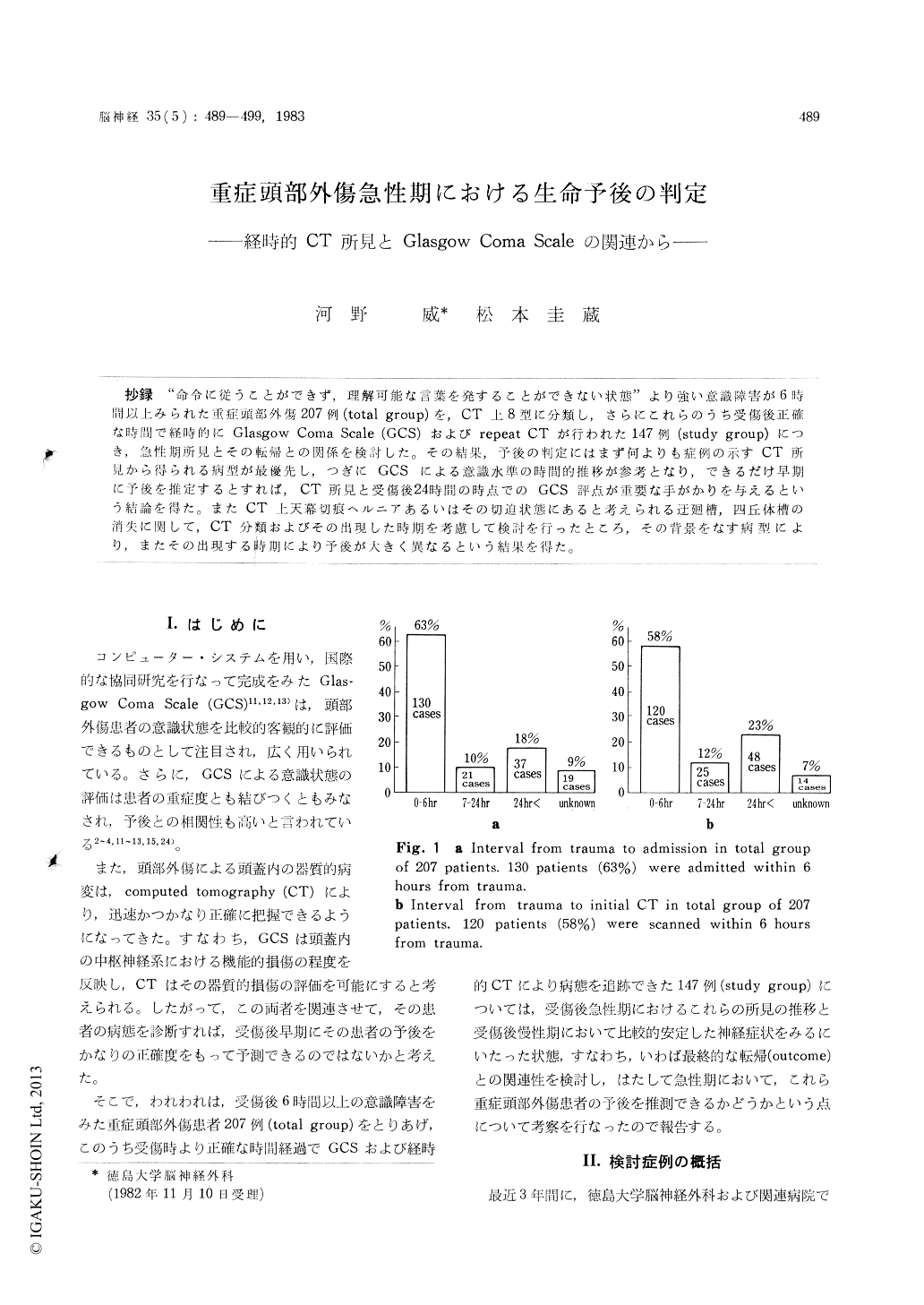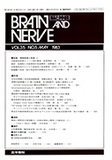Japanese
English
- 有料閲覧
- Abstract 文献概要
- 1ページ目 Look Inside
抄録 "命令に従うことができず,理解可能な言葉を発することができない状態"より強い意識障害が6時間以上みられた重症頭部外傷207例(total group)を,CT上8型に分類し,さらにこれらのうち受傷後正確な時間で経時的にGlasgow Coma Scale (GCS)およびrepeat CTが行われた147例(study group)につき,急性期所見とその転帰との関係を検討した。その結果,予後の判定にはまず何よりも症例の示すCT所見から得られる病型が最優先し,つぎにGCSによる意識水準の時間的推移が参考となり,できるだけ早期に予後を推定するとすれば,CT所見と受傷後24時間の時点でのGCS評点が重要な手がかりを与えるという結論を得た。またCT上天幕切痕ヘルニアあるいはその切迫状態にあると考えられる迂廻槽,四丘体槽の消失に関して,CT分類およびその出現した時期を考慮して検討を行ったところ,その背景をなす病型により,またその出現する時期により予後が大きく異なるという結果を得た。
The Glasgow Coma Scale (GCS) has become popular throughout the world as one of the most reliable method for the evaluation of the level of consciousness concerning patients with head injur-ies in the acute stage. An attempt to define the outcome by Glasgow Outcome Scale with it has also been reported. However, at the evaluation of GCS of these patients in acute stages, little atention has been paid to the variation of the type of their intracranial lesions and the timing of evaluatiion.
The basic conceptions in this paper are 1) CT findings of the patients may offer us pathological condition of the various types of their intracranial lesions and 2) GCS, which may represent their functional disabilities objectively, should be eva-luated sequentially. The earlier prognostic appra-isal may be obtained with serial CT information and the correlated sequential evaluation of the GCS score in the acute stage of the head-injured patients.
207 cases (total group) of severely head-injured, who showed a lowering level of consciousness less than "not obeying commands" and "not utter-ing any reconizable words", were classified into the following 8 types according to their CT findings. Namely, type 1: epidural hematoma (EDH) with 36 cases, type 2: subdural hematoma (SDH) with 19 cases, type 3: parenchymal lesion (PL) including contusion and intracerebral hema-toma with 78 cases, type 4: EDH+PL with 13 cases, type 5: SDH I- PL with 31 cases, type 6:EDH SDH PL with 6 cases, type 7 : cerebral swelling only (CS) with 11 cases and type 8: no abnormality (NA) with 13 cases.
The mortality rate of the total group was 28% (type 1-3%, type 2-47%, type 3-29%, type 4-0 %, type 5-65%, type 6-83%, type 7-0%, type 8-0%).
Out of the total group, there were 147 cases (study group) who had precise clinical recordings with the sequential scores of GCS and the corre-sponding serial CT examination in the acute stage. Study group showed 33% mortality rate (type 1-5%, type 2-56%, type 3-38%, type 4-0%, type 5-59%, type 6-67%, type 7-0%, type 8-0%). There were no significant difference (p<0.05) in mortality and morbidity between the total group and the study group statistically, The study group was divided into two groups according to the survey of their outcome. Group A who had apparently good outcome after surgical and medical treatment. They showed no relation to the GCS score in the acute stage. On the other hand, the cases of Group B had various grades of outcomes. 45 cases of types 1, 4, 7 and 8 were included in Group A. The other types (type 2,3, 5 and 6) of 102 cases were in Group B. Sequential evaluation of GCS in a very early period of the acute stage in Group B showed a rather unstable score in some cases. However, at the time of 24 hours after the accident, the majority of the casesreached scores that related to the outcome. Out of the 45 of the 48 dead cases, GCS scores were less than 5 at the particular time. On the other hand, 42 of 43 useful survival cases with good recovery and moderate disability showed score 7 or more at the time of this point.
Clinical implication of the disappearance of the quadrigeminal and the ambient cisterns were also investigated. In Group A, the disappearance of these cisterns was noted in 10 cases within 6 hours after the accident and only one case died (10%). 3 cases showed it in the period of 7 to 24 hours after the accident and all recovered well. In Group B, the disappearance of the cisterns was noted in 43 cases within 6 hours after the accident and 35 cases (81%) were dead. 19 cases showed it in 7 to 24 hours after the accident and 15 cases were dead (78%). 15 cases showed it in 24 or more hours later and 4 cases (27%) were dead.
As a conclusion for this study, a combined judgement of repeated CT and sequential evalua-tion of the GCS for severe head-injured cases may lead us to a more accurate prognostic appraisal in the very early acute stage, at least, at the time of 24 hours after the accident. And the disappearance of the quadrigeminal and the ambient cisterns may have different values between Group A and B, and also according to the timing of it's appear-ance.

Copyright © 1983, Igaku-Shoin Ltd. All rights reserved.


